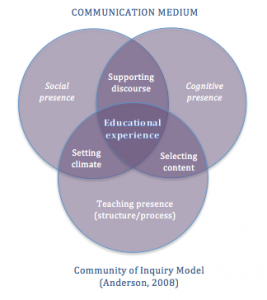Rationales for choosing a discussion forum as a communication tool
 I chose to create an Interactive writing activity using an “Asynchronous Communication”
I chose to create an Interactive writing activity using an “Asynchronous Communication”
tool to amplify meaningful and deep interactions within learning communities. A discussion forum was selected to promote Anderson’s community of inquiry model, to accommodate time zone differences, and to give students time to reflect deeply on discussion topics.
First, a discussion forum is the right communication tool to promote a community of inquiry model (Garrison, Anderson, and Archer, 2000). The model postulates that sufficient levels of three types of component presence – cognitive presence, teacher presence and social presence – foster deep and meaningful learning results (Anderson, p. 344).
Cognitive presence is achieved when students interact with discussion topics carefully chosen by a teacher. Students need to think thoughtfully and critically about the topics to rationalize their answers. Also, sufficient social presence can be attained through active peer interactions within the forum. The forum can help students construct knowledge collaboratively in a supportive environment such that students can feel comfort and safety to express their ideas (Anderson, p. 344). Lastly, teaching presence can be achieved by applying three important teaching practices: designing learning experiences within learning communities, selecting topics to encourage discourse both among students and between teachers and students, and adding subject-matter expertise in learning communities. Discussion forums allow teachers act effectively as e-moderators, a subject-matter experts, and learning designers. Most of all, teachers and students can collaborate to construct knowledge and to develop trusted learning communities.
Second, another benefit of utilizing a discussion forum is allowing students to have time to reflect deeply before posting their ideas and reflections. The hot issue topic activity forum in Moodle has been setup as a communication space to discuss sensitive, ethical or social issues related to the software industry. Thus, the forum requires more careful and thoughtful responses.
Third, a discussion forum is an asynchronous communication tool that allows students to post their thoughts any time any place. The tool greatly increases the flexibility of online courses. Most of all, students enrolled in different time zones can get great benefits out of this flexibility.
Concerns
Utilizing a discussion forum as a communication tool can potentially have two distinctive downsides. One issue is information overload. A discussion forum can generate many postings and it can be overwhelming to read all of them. It is also difficult to respond to each posting. This problem can be addressed by assigning a forum moderator (a teacher or a student) who would split any irrelevant topic from the original thread and organize it as a separate topic. That relieves the workload.
The other issue is that prompt feedback is somewhat restricted due to the asynchronous nature of the tool. The discourse can be discontinued if there is no response from the original posters within a given time frame. We could ease the situation by allowing the forum to be open until the course ends.
Tools available for tracking students’ activities in Moodle
The Course Participation report will provide teachers with meaningful activity statistics: it will show who viewed postings and posted replies. The report allows teachers to track each student’s activity level within the course. Also, the auto subscription mode in a discussion forum helps teachers track activities in that virtual public space.
Reference:
Anderson, T. (2008b). Teaching in an Online Learning Context. In: Anderson, T. & Elloumi, F. Theory and Practice of Online Learning. Athabasca University. Accessed online 3 March 2009.
http://www.aupress.ca/books/120146/ebook/14_Anderson_2008-Theory_and_Practice_of_Online_Learning.pdf
